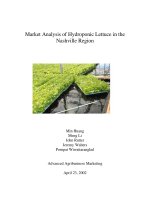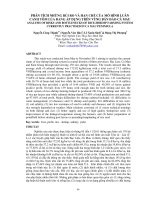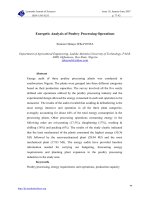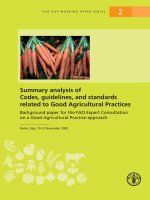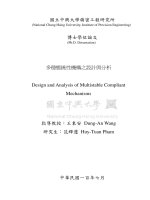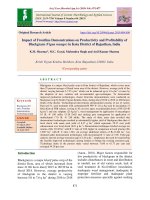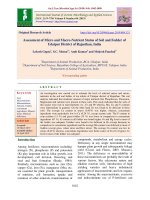Phytochemical analysis of plant resources having antimicrobial properties obtained from Aravali Hills of Rajasthan, India
Bạn đang xem bản rút gọn của tài liệu. Xem và tải ngay bản đầy đủ của tài liệu tại đây (211.4 KB, 5 trang )
Int.J.Curr.Microbiol.App.Sci (2018) 7(3): 1121-1125
International Journal of Current Microbiology and Applied Sciences
ISSN: 2319-7706 Volume 7 Number 03 (2018)
Journal homepage:
Original Research Article
/>
Phytochemical Analysis of Plant Resources having Antimicrobial Properties
Obtained from Aravali Hills of Rajasthan, India
Sudha Babel*, Rupali Gupta and Latika Sachihar
Department of Textiles & Apparel Designing, College of Home Science, MPUAT,
Udaipur, India
*Corresponding author
ABSTRACT
Keywords
Antimicrobial properties,
Antimicrobial activity,
Phyo chemical analysis
Article Info
Accepted:
10 February 2018
Available Online:
10 March 2018
Medicinal plants have age long remedies for human diseases because they contain
components of curative value. An increasing interest in herbal remedies is observed in
several parts of India and many of the herbal remedies are incorporated into traditional
medicinal plant practice. In the present study questions related diseases that have been
managed traditionally using medicinal plant were asked by sixty respondents. Collected
data were analysed. The study reports the plant sources used by rural women to cure the
various diseases and phytochemical analysis plant sources used by the women. On the
basis of the study it can be concluded that these plant resources may serve as a potential
source for wet finish application on the textiles for treatment of skin wounds, antifungal,
anti-microbial finish, hence further research should be conducted in order to explore their
applications.
Introduction
According to World Health Organization
(WHO) more than 80% of the world's
population relies on traditional medicine for
their primary healthcare needs. Use of herbal
medicines in Asia represents a long history of
human interactions with the environment.
Plants used in traditional medicine contain a
wide range of ingredients that can be used to
treat chronic as well as infectious diseases. A
vast knowledge of how to use the plants
against different illnesses may be expected to
have accumulated in areas where the use of
plants is still of great importance (Diallo et al.,
1999). The medicinal value of plants lies in
some chemical substances that produce a
definite physiological action on the human
body. The most important of these bioactive
compounds of plants are alkaloids, flavonoids,
tannins and phenolic compounds (Edeoga et
al., 2005). Developing countries like India
depend on plant resources mainly for herbal
medicines, food, forage, construction of
dwellings, making household implements,
sleeping mats, and for fire and shade.
The use of medicinal plants as traditional
medicines is well known in rural areas of
many developing countries (Sandhu and
Heinrich, 2005; Gupta et al., 2005).
Traditional healers claim that their medicine is
cheaper, more effective and impart least side
effects as compared to synthetic medicines. In
1121
Int.J.Curr.Microbiol.App.Sci (2018) 7(3): 1121-1125
developing countries, low-income people such
as farmers, people of small isolate villages and
native communities use folk medicine for the
treatment of common infections (Rojas et al.,
2006). For millennia, the Indian population
has depended upon mostly plant based crude
drugs for the treatment of variety of human
ailments. India has about 18,000 species of
angiosperms, of with about 2,500 species are
considered as important source of medicinal
and aromatic chemical components in modern
medicine also, plants occupy a very significant
place as raw material for some important
drugs.
Antimicrobial
Properties
and
the
phytochemical analysis for different plant
extracts.
Phyto-chemical screening of plant sources
The identified plant sources of the region were
subjected to phyto-chemical analysis for
screening of plant sources for their
antimicrobial properties.
Materials and methods for phyto-chemical
screening of plant sources
Selection of the plant sources
Undulating hills of Aravali, supporting the dry
deciduous forests, provide an unimaginable
beautiful
ambience.
The
area
is
characteristically rich in floral diversityparticularly medicinal plants. It has numerous
floral and faunal species of global
conservation significance. The rare flora
comprises Kadaya (giving medicinal gum),
Gugal, amla and Moosli etc. The predominant
trees are- Khair, Salai, Modad, Dhavada,
Khakhara, Timru. During late winters
(February-March) Khakhara-the flame of the
forests- known by many different names such
as- Palash, Tesu, Kesudo, Dhak etc. is
generally in bloom with its striking red colour
resembling
flames
in
the
forests
rajasthantrekking.com/thearavalis.htm
In general, these plants are used in folk
medicine in the treatment of skin diseases,
venereal diseases, respiratory problems and
nervous disorders. There is lack of scientific
studies on these selected plants. Screening of
medicinal plants for antimicrobial activities
are important for finding potential new
antimicrobial finishes for textiles. This paper
based on results of survey conducted in
Udaipur where the questions about plant
sources used for curing the diseases were
asked, on the basis of results this paper reports
documentation of Plant Resources having
The leaves of ten plant sources were collected
in around operational villages which were
washed with distil water, shade dried and
powdered.
Solvents used in extraction procedures
Ethanol, Methanol, Chloroform, Acetone and
distil water.
Preparation of plant extract by aqueous
decoctions
20 gms of dry leaf powder of selected plant
sources was boiled in 100ml distilled water for
15 minutes, it was allowed to cool and then
filtered. The filtrate was used as the aqueous
decoctions.
The leaf extracts of eleven plant sources were
analyzed for the presence of flavonoids,
alkaloids, phenols, saponins, terpenoid and
tannins according to standard methods.
Alkaloids [Mayer's test]
1.36gm of mercuric chloride dissolved in
60ml and 5gm of potassium iodide were
dissolved in 10 ml of distilled water
respectively. These two solvents were mixed
1122
Int.J.Curr.Microbiol.App.Sci (2018) 7(3): 1121-1125
and diluted to l00ml using distilled water. To
one ml of acidic aqueous solution of samples
few drops of reagent was added. Formation of
white or pare precipitate showed the presence
of alkaloids.
Terpenoid
2ml of chloroform and 1ml of concentrated
H2SO4 was added to 1 mg of extract and
observed for reddish brown colour that
indicated the presence of terpenoid.
Flavonoids
Results and Discussion
In a test tube containing 0.5ml of extract of the
samples, 5 to10 drops of diluted HCI and
small amount of Zn and Mg were added and
the solution was boiled for few minutes.
Appearance of reddish pink or dirty brown
colour indicated the presence of flavonoids.
Phyto-chemical screening of plant sources
The identified plant sources of the region were
subjected to phyto-chemical analysis for
screening of plant sources for their
antimicrobial properties.
Saponins
A drop of sodium bi-carbonate was added in a
test tube containing about 50ml of an aqueous
extract of sample. The mixture was shaken
vigorously and kept for 3min. A honey comb
like froth was formed and it showed the
presence of saponins.
Phenols [Ferric chloride test]
To 1ml of alcoholic solution of sample, 2ml of
distilled/water followed by a few drops of
10% aqueous ferric chloride solution were
added. Formation of blue or green colour
indicated the presence of phenols.
Tanins [Lead acetate test]
In a test tube containing about 5ml of an
aqueous extract, a few drops of 1 % solution
of lead acetate was added. Formation of a
yellow or red precipitate indicated the
presence of tannins.
FeCl3 test
A 2ml filtrate [200mg of plant material in
10ml distilled water, filtered], and 2ml of
FeCI3 were mixed. A blue or black precipitate
indicated the presence of tannins
The results of the phytochemical screening in
Table 1 indicated the presence of Alkaloids,
glycosides, saponin, phenols, steroids etc. The
presence of these secondary metabolites has
contributed to its medicinal value as well as
physiological activity. For instance Flavonoids
have been referred to as nature’s biological
response modifiers, because of their inherent
ability to modify the body’s reaction to
allergies and virus and they showed their antiallergic, anti-inflammatory, anti-microbial and
anti-cancer activities. The positive effects of
glycoside and cardiac glycoside are not
common but their toxic effects include
decreased heart rate, sympathetic activity and
systematic vascular resistance. The presence
of some of these anti nutrients can be reduced
by various processing technique. Plant steroids
possess insecticidal and antimicrobial
properties. They are also used in nutrition,
herbal medicine and cosmetics.
Tannins were reported to exhibit antiviral,
antibacterial and anti-tumour activities. It was
also reported that certain tannins were also
used as diuretic. Tannins can be used as an
anti-bacterial because it has phenon group, so
tannin have properties like alcohol, an
antiseptic that can be used as antimicrobial
component.
1123
Int.J.Curr.Microbiol.App.Sci (2018) 7(3): 1121-1125
Table.1 Phyto-chemical screening of plant sources
S.no.
Plant sources
1
Ratanjot
Leaves
2
Neem leaves
3
Karanch
leaves
4
Peepal
Leaves
5
Chemeli
Leaves
6
Mahuaa
Leaves
7
Heena
Leaves
8
Amaltas
Leaves
9
Guava
Leaves
10
Jammun
Leaves
11
Arandi leaves
Medium of extraction
Methanol
Ethanol
Chloroform
Acetone
Water
Methanol
Ethanol
Chloroform
Acetone
Water
Methanol
Ethanol
Chloroform
Acetone
Water
Methanol
Ethanol
Chloroform
Acetone
Water
Methanol
Ethanol
Chloroform
Acetone
Water
Methanol
Ethanol
Chloroform
Acetone
Water
Methanol
Ethanol
Chloroform
Acetone
Water
Methanol
Ethanol
Chloroform
Acetone
Water
Methanol
Ethanol
Chloroform
Acetone
Water
Methanol
Ethanol
Chloroform
Acetone
Water
Methanol
Ethanol
Chloroform
Acetone
Water
Alkaloids
+
+
+
+
+
+
+
+
+
+
+
+
+
+
+
+
+
+
+
+
+
+
+
+
+
+
+
+
-
Flavonoids
+
+
+
+
+
+
+
+
+
+
_
+
+
+
+
+
+
+
+
+
+
+
+
+
+
+
+
+
+
+
-
-
-
+
+
+
1124
Saponins
+
+
+
+
+
+
+
+
+
+
+
+
+
+
+
+
+
+
+
+
+
+
+
+
+
-
Phenol
+
+
+
+
+
+
+
+
+
+
+
_
+
+
+
+
+
+
_
+
+
+
+
+
+
+
+
+
+
+
+
+
+
+
+
-
Tannins
+
+
+
+
+
+
+
+
+
+
+
+
+
+
+
+
+
+
+
+
+
+
+
+
+
+
+
+
+
+
+
+
+
+
+
+
-
Terpenoids
+
+
+
+
+
+
+
+
+
+
+
+
+
+
+
+
+
+
+
+
+
+
+
+
+
+
+
+
+
+
+
+
+
+
+
+
+
+
+
-
Int.J.Curr.Microbiol.App.Sci (2018) 7(3): 1121-1125
Saponin is used as mild detergents. It is also
used to allow antibody access in intracellular
proteins. In medicine, it is used in
hypercholesterolemia, hyperglycaemia, antioxidant,
anticancer,
antifungal,
antiinflammatory, weight loss, etc.
From the present study, it can be assumed that
these leaves may serve as a potential
application for treatment of skin wounds,
antioxidant, antifungal, anti-allergic, antiinflammatory, anti-microbial etc, The results
obtained from phyto chemical revealed that
the plants contained bioactive agents which
are connected with antimicrobial properties in
plants. These agents are alkaloids, saponins,
flavonoids and tannins. Further research is
needed to find out the uses of these extracts
for the application of antimicrobial finishes
on the textiles.
References
Erdogrul OT (2002). Antibacterial activities
of some plant extracts used in folk
medicine.
Pharmaceutical
Biol.
40:269–273.
Hewitt W, Vincent S (1989). In: Theory and
application of microbiological assay.
Academic Press, San Diego, p. 39.
Trekking
in Rajasthan, India
Jain A, Katewa SS and Galav PK, (2005).
Some phyto therapeutic claims by
tribals of southern Rajasthan, Indian J
Traditional Knowledge, 4 (3) 291.
Jain SK, (1975). Medicinal plants, 2nd edn,
(National Book Trust of India, New
Delhi),
Katewa SS and Arora A, (1997) Some plants
of folk medicine of Udaipur district,
Rajasthan, Ethnobotany, 9 48.
Katewa SS, Chaudhary BL, Jain A and Galav
PK, (2003) Traditional uses of plant
biodiversity from Aravalli hills of
Rajasthan, Indian J Traditional
Knowledge, 2 1.
Nostro A, Germano MP, D'Angelo V, Marino
A, Cannatelli MA (2000). Extraction
methods and bioautography for
evaluation
of
medicinal
plant
antimicrobial activity. Lett. Appl.
Microbiol. 30(5): 379.
Rojas JJ, Ochoa VJ, Ocampo SA, Muñoz JF
(2006). Screening for antimicrobial
activity of ten medicinal plants used in
Colombian folkloric medicine: A
possible alternative in the treatment of
non-nosocomial
infections.
BMC
Complementary
and
Alternative
Medicine. 6:2.
Sebastian MK and Bhandari MM, (1984)
Medicinal plant lore of Udaipur district
Rajasthan, Bull Med Ethnobot Res, 5 (34) 133.
Singh V and Panday RP, (1980) Medicinal
plant lore of the tribals of eastern
Rajasthan, J Econ Tax Bot, 1 137.
How to cite this article:
Sudha Babel, Rupali Gupta and Latika Sachihar. 2018. Phytochemical Analysis of Plant
Resources having Antimicrobial Properties Obtained from Aravali Hills of Rajasthan, India.
Int.J.Curr.Microbiol.App.Sci. 7(03): 1121-1125. doi: />
1125
